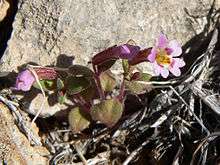Erythranthe rubella
Erythranthe rubella is a species of monkeyflower known by the common name little redstem monkeyflower. It was formerly known as Mimulus rubellus.[1][2][3][4]
| Erythranthe rubella | |
|---|---|
 | |
| Scientific classification | |
| Kingdom: | Plantae |
| Clade: | Tracheophytes |
| Clade: | Angiosperms |
| Clade: | Eudicots |
| Clade: | Asterids |
| Order: | Lamiales |
| Family: | Phrymaceae |
| Genus: | Erythranthe |
| Species: | E. rubella |
| Binomial name | |
| Erythranthe rubella (A.Gray) N.S.Fraga | |
Distribution
It is native to western North America, including the southwestern United States to Wyoming and Texas, and into Baja California.
Description
Erythranthe rubellus is an annual herb growing 2 to 32 centimeters tall with a very slender, red stem. The oppositely arranged oval leaves are up to 3 centimeters long and lance-shaped to oval, the lower ones borne on short petioles. The herbage is usually lightly hairy and green to reddish in color.
The petite tubular flower is no more than a centimeter long, the base of its tube encapsulated in a narrow, ribbed calyx of sepals. The flower may be yellow or pink in color and the mouth of the flower is usually dotted with red or purple.
References
- Barker, W.R.; Nesom, G.L.; Beardsley, P.M.; Fraga, N.S. (2012), "A taxonomic conspectus of Phrymaceae: A narrowed circumscriptions for Mimulus, new and resurrected genera, and new names and combinations" (PDF), Phytoneuron, 2012–39: 1–60CS1 maint: uses authors parameter (link)
- Beardsley, P. M.; Yen, Alan; Olmstead, R. G. (2003). "AFLP Phylogeny of Mimulus Section Erythranthe and the Evolution of Hummingbird Pollination". Evolution. 57 (6): 1397–1410. doi:10.1554/02-086. JSTOR 3448862.
- Beardsley, P. M.; Olmstead, R. G. (2002). "Redefining Phrymaceae: the placement of Mimulus, tribe Mimuleae, and Phryma". American Journal of Botany. 89 (7): 1093–1102. doi:10.3732/ajb.89.7.1093. JSTOR 4122195. PMID 21665709.
- Beardsley, P. M.; Schoenig, Steve E.; Whittall, Justen B.; Olmstead, Richard G. (2004). "Patterns of Evolution in Western North American Mimulus (Phrymaceae)". American Journal of Botany. 91 (3): 474–4890. doi:10.3732/ajb.91.3.474. JSTOR 4123743. PMID 21653403.